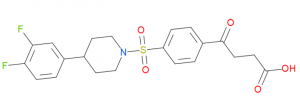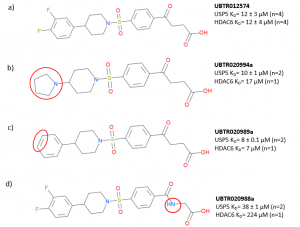In a previous post, we solved the co-crystal structure of the USP5 zinc finger ubiquitin-binding domain (ZnF-UBD) with a promising compound, UBTR012574, which had a potency of approximately 10 µM (Figure 1). W expanded the chemical series of UBTR012574 by docking analogue compounds from the Enamine REAL database and Scifinder. We decided to order 17 of these compounds based on the docking poses and assessed the binding potency using a surface plasmon resonance (SPR) assay. You can find details of the experiment on Zenodo.

Figure 1. UBTR012574
Of the analogues tested, UBTR020994a and UBTR020989a had a similar potency as UBTR012574 for USP5 ZnF-UBD. These compounds also bind to HDAC6 ZnF-UBD with similar potency. Compound UBTR020988a, which has a nitrogen atom in the carboxylic chain results in weaker potency (~40 µM) than UBTR012574 for USP5 ZnF-UBD but is 6-fold selective for USP5 over HDAC6 (Figure 2). We are working with chemists to expand the chemical series further with the nitrogen group in the carboxylic chain- we hope to improve potency and retain selectivity for USP5 ZnF-UBD. Stay tuned!

Figure 2. UBTR012574 chemical series a) UBTR012574 b) UBTR020994a c) UBTR020989a d) UBTR20988a
| Structure Image | Smiles | Mol. Weight |
|---|---|---|
| O=C(O)CCC(=O)c1ccc(S(=O)(=O)N2CCCC(C(F)(F)F)C2)cc1 | 393.4 | |
| O=C(O)CCC(=O)c1ccc(S(=O)(=O)N2CCC3(CCO3)CC2)cc1 | 367.4 | |
| O=C(O)CCC(=O)c1ccc(S(=O)(=O)N2CCC(c3ccc(F)c(F)c3)CC2)cc1 | 437.5 | |
| O=C(O)CCC(=O)c1ccc(S(=O)(=O)N2CCSCC2)cc1 | 343.4 | |
| O=C(O)CNC(=O)c1ccc(S(=O)(=O)N2CCC(c3ccc(F)c(F)c3)CC2)cc1 | 438.5 |
